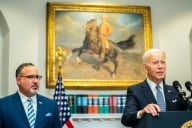You have /5 articles left.
Sign up for a free account or log in.
When talking about teaching and the curriculum, a major theme of the professors, deans and provosts involved in the Association of American Colleges and Universities is that it is time to shift attention away from debating whether students should take X semesters of the humanities and Y years of science, and to focus instead on qualities of learning that students need. By focusing on those qualities, instead of fighting over numbers, the theory goes, colleges will be improving education.
For students to have both the rigor of critical thinking and the substance they need for the changing world, the AAC&U argues in various reports, students also need exposure to multidisciplinary approaches to learning -- that don't sacrifice on subject matter, but that promote "integrative" education, combining disciplines, combining academic and non-academic experiences, and so forth.
As association members gathered in New Orleans this week for the group's annual meeting, much of the discussion revolved around ways to promote such education -- acknowledging that the realities of campus politics (and budgets) can pose obstacles.
One session focused on how team teaching could move beyond typical models and could grow generally. Stuart L. Belli, a professor of chemistry at Vassar College, spoke about the importance of having course content that explores both the science and the policy issues at deep levels. He said that in his training, right through graduate school, such perspective wasn't provided. "What went on in a beaker, I completely understood," he said. But if science students today are similarly limited -- or if social science students don't get anything about science -- they will have been given an inadequate education.
Team teaching is one obvious answer, he said, but participants at the meeting noted some of the tougher questions that approach raises. For the team to be a true team, both professors should be involved in every class, even if in some of the classes the instructors are more akin to students. When deans are drawing up budgets, however, they may not want two tenured professors to have one of their class assignments be teaching a seminar of 15 together.
One solution being tried at Vassar is the "course intersection," in which two courses might merge for two weeks. Belli teaches analytic chemistry. A colleague teaches urban studies. A two-week period of both courses, planned in advance, might focus on lead poisoning issues, with the chemistry professor teaching the science and an urban studies colleague focused on policy. Students' assignments would force the non-science students to do some serious science, while the chemistry students would focus more than they might otherwise on the policy implications of scientific findings.
Similarly, Vassar has created the Multidisciplinary Team Enhanced Teaching Method, in which various professors agree to participate in other courses, sometimes briefly and sometimes for more significant periods. This approach could involve two professors or five or more.
Hal L. Holladay, a professor of English at Simon's Rock College, of Bard College, offered another way to encourage cross-disciplinary teaching. Simon's Rock has changed the capstone course concept -- in which seniors take an in-depth seminar -- so that these courses involve two professors from different disciplines. In one such course, a philosophy professor and a mathematics professor explored the impact of mathematics on political theory. In another, a psychologist and biologist examined biology debates at the start of the millennium.
Students learn in part by seeing professors learn from other professors, Holladay said. "We model ignorance," he said. "When I teach with a physicist, I show what I don't know."
While all of this creates more work for professors, Holladay said it was essential for students. Disciplines "are not representative of the world or of nature," he said.
Also at the meeting Thursday, AAC&U and the Carnegie Foundation for the Advancement of Teaching released a joint report, "Integrative Learning: Opportunities to Connect," which examined how 10 colleges have focused on encouraging students to be more deliberate and ambitious in their learning, outside of traditional categories of classes and disciplines.
"The undergraduate experience is often a fragmented landscape of general education, concentration, electives, co-curricular activities, and for many students 'the real world' beyond campus," said Mary Huber, a senior scholar with the Carnegie Foundation who co-directed the project. "An emphasis on integrated learning can help undergraduates find ways to put the pieces together and develop habits of mind that will prepare them to make informed judgments in the conduct of personal, professional and civic life.








